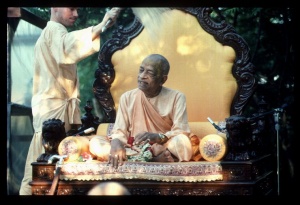CC Adi 2.29 (1975)

A.C. Bhaktivedanta Swami Prabhupada
Below is the 1996 edition text, ready to be substituted with the 1975 one using the compile form.
TEXT 29
- iṅhota dvi-bhuja, tiṅho dhare cāri hātha
- iṅho veṇu dhare, tiṅho cakrādika sātha
SYNONYMS
iṅhota—this one; dvi-bhuja—two arms; tiṅho—He; dhare—manifests; cāri—four; hātha—hands; iṅho—this one; veṇu—flute; dhare—holds; tiṅho—He; cakra-ādika—the wheel, etc.; sātha—with.
TRANSLATION
This Personality of Godhead [Śrī Kṛṣṇa] has two hands and holds a flute, whereas the other [Nārāyaṇa] has four hands, with conch, wheel, mace and lotus.
PURPORT
Nārāyaṇa is identical to Śrī Kṛṣṇa. They are in fact the same person manifested differently, like a high-court judge who is differently situated in his office and at home. As Nārāyaṇa the Lord is manifested with four hands, but as Kṛṣṇa He is manifested with two hands.